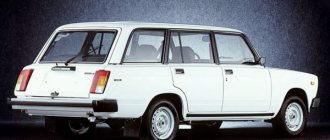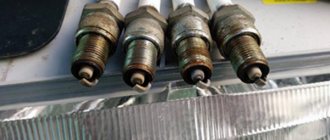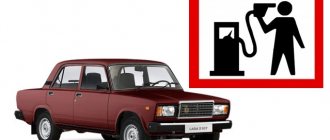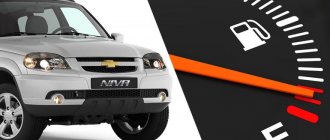Before taking measures to find problems associated with increased consumption, you first need to measure fuel consumption. This process is not complicated.
Fill up your car, reset the odometer to zero, and continue driving. Try to drive the car quite calmly, without making sudden maneuvers, then the odometer will show fairly accurate fuel consumption readings.
Now knowing exactly how much fuel you filled at your last refueling, divide the amount of fuel used by the kilometers traveled and multiply by one hundred. After which you will have the result of fuel consumption, and determine the fuel consumption with minimal errors. This will allow you to understand whether the problem with high fuel consumption is worth solving, or whether the injector is fine and your car is consuming the right amount of fuel.
Restyling
Most Russians prefer domestic cars to foreign cars, and most of the models were produced a long time ago.
Among modern cars - VAZ-2109. But the vehicle is both technically and morally outdated. Restyling will help give the car a second life.
Many people are interested in where to start. All Russian cars, regardless of the year of manufacture, have a common problem - the level of sound insulation.
This does not apply to those who like to drive slowly, but there are vehicles that accelerate to 90 km/h and above; you have to shout so that the passengers sitting behind can hear the driver.
Dashboard. The next level is advanced car restyling. In this case, the most dramatic changes to the car are coming.
VAZ-2109 1.6 injector
In 2001, the VAZ-210934-20 model appeared. As a power unit, it uses an injection four-cylinder 8-valve VAZ-11183-20 engine with a volume of 1596 cm3. It produces 81 hp. and a torque of 120 Nm and is combined with a 5-speed manual transmission.
Real reviews about fuel consumption of VAZ-2109 1.6 injector per 100 km
- Evgeniy, Ekaterinburg. I’ll say right away that I bought the car to drive. There is nothing native left in her anymore. The engine is 1.6 liters and that friend rebuilt and rebuilt it for me, it now produces more than 100 horses. Consumption, of course, has also increased - in the city it’s about 14 liters, if you drive calmly it’s about 10 liters. But I like it and do everything at the traffic light.
- Ilya, Samara. After I got my license in 2005, I had exclusively domestic cars for almost 8 years. The latest from our automobile industry is VAZ-210934-20, with a 1.6 liter injection engine. The car was produced in 2001, it has covered 150 thousand in 10 years. After the purchase, the engine, suspension and everything else were overhauled - the rest did not cause problems. I’ll tell you, the car is reliable and unpretentious, if you look after it, and it’s also economical - in the city it’s never been more than 9 liters, on the highway it’s about 5 liters in general.
- Denis, Anzhero-Sudzhensk. I bought a car from my father - he still saved up the money to switch to a foreign car, but I got my own car. Its main feature is the engine, 1600 cubes. Consumption in the city is about 10 liters, well, for any car with such an engine it is almost identical. I drove it for a year and a half and decided that it was expensive to refuel with gasoline - I installed an LPG system. Consumption has increased, but this is also because I stopped saving - now in the city I have a stable 12-13 liters, but given the price of gas, this doesn’t bother me at all.
- Kirill, Barnaul. I don’t care about those who criticize the domestic auto industry. Yes, it may be inferior in quality and reliability to foreign cars, but it is also much cheaper to buy and to operate. And if your arms are straight, then everything will be fine. I bought it with a mileage of 150 thousand - I only replaced the chassis, pump and cooling fan. The timing belt was changed at 175,000 km!!! The 1.6 liter engine performs very well, the brain did not float at all. And also economical - in mixed mode it never produced more than 7.5 liters.
- Timofey, Sergiev Posad. "Nine" with a 1.6 liter injector, 2003. Before it there was a “five” - when I changed, it seemed like I was driving a foreign car. Consumption up to 12 in the city and 7 on the highway, I adjusted everything to suit myself - in general, it didn’t bother me at all for 3 years (although I still did minor repairs). Now I’m thinking of selling and buying a Skoda.
- Vasily, Krasnoozerskoe. VAZ is a VAZ. You always know what to expect from him, you know that even with serious repairs you will be able to support him financially. And it carries its rear just like a foreign car. The downside is the constant noise in the cabin, everything creaks and rattles. Consumption on the highway is about 7.5 liters, in the city 10 liters.
The VAZ 2109 has been in demand in our country since the very start of production. At one time, this car didn’t look too bad and had good technical characteristics (by Soviet standards), so it’s not surprising that the model remains beloved even now, even after production of this variant has long ceased.
When purchasing a similar option for active use, it is recommended to pay attention to some nuances that may increase the owner’s planned expenses during the period of use of the car. For example, the actual fuel consumption of a VAZ 2109 may not correspond to that declared by the manufacturer.
Actual fuel consumption depending on engine type
In addition to cars with a standard body, in 1995-99. A Baltic modification was assembled in Finland, which differed in the design of the interior, front and rear. All assembled hatchbacks were equipped with a 1.5-liter VAZ-2111 engine. Fuel consumption did not differ from that of its Russian counterparts. The table shows the engine models and the efficiency characteristics declared by the AvtoVAZ plant (in liters per 100 km).
Most of the hatchbacks built were used by the Ministry of Internal Affairs. Cars are periodically found on the secondary market.
Data sheet consumption values for modifications 2109
During the production history of the Lada Nine, it was produced with five types of eight-valve engines, which differ slightly in terms of fuel consumption. Below are the engine models and their rated values for gasoline consumption per 100 km on a combined cycle.
Injection engines straight from the VAZ 2109 factory have higher fuel consumption than carburetor engines. But during operation, the fuel consumption of an injection engine does not increase as much as that of a carburetor engine, so we will not consider the fuel consumption of the VAZ 2109 injector in detail. Let us dwell on the reasons that often cause increased fuel consumption on modifications of the Lada Samara with a carburetor.
With timely troubleshooting of problems that affect overconsumption and proper driving of the car, you can achieve optimal gasoline costs.
How to reduce gasoline consumption in a VAZ
VAZ 21099 is a rather rare modification of this car brand, created for import to other countries. All its embedded data indicates average fuel consumption, power, speed, convenience and practicality. In terms of fuel consumption VAZ 21099, the injector also has advantages over its predecessors. To reduce fuel consumption on a VAZ, you need to do the following:
- clean the fuel filter;
- check for fuel leaks;
- adjust the carburetor;
- configure lambda umbrella;
- warm up the engine to operating temperature so that the fuel does not just flow out, but warms up and is consumed.
The owner of a VAZ 21099 already knows in practice what still needs to be done to reduce gasoline consumption.
Fuel consumption outside the city
VAZ 21099 with a 1.5 liter engine and 135 horsepower is quite practical for driving outside the city, through fields. But do not neglect its practicality and go on dirt roads in the rain and slush. On such a road, a VAZ may require about 10 liters per 100 km.
Therefore, after filling the tank, you need to calculate the distance, as well as the necessary additional consumption. When off-road, try to drive at one speed, do not switch from one to the next, and then back - this will lead to an increase in the amount of gasoline used.
Gasoline consumption VAZ 21099 - carburetor. Fuel consumption rate
VAZ 21099 in detail about fuel consumption
In 1990, the production of the well-known “99” – VAZ 21099 – started. Now, it does not lose its popularity among buyers. The fuel consumption of the VAZ 21099 per 100 km is of interest to almost every future owner - it is about 11 liters. Driving a car, engine type, and road surface directly affect fuel consumption. In addition, there is a strong dependence on the year of manufacture; the newer the car, the more economical it is and uses less fuel. Next, we’ll talk more precisely about how to reduce the gasoline consumption of a VAZ 21099 and what can be modified for the desired savings.
What determines the cost of a VAZ?
A front-wheel drive sedan is considered a Russian car, which is intended for traveling on Russian highways. Lada models from 2000 to 2007 have an engine capacity of 1.5 liters. Based on driver reviews, we can conclude that the car feels better in the city than off-road.
| Engine | Consumption (highway) | Consumption (city) | Consumption (mixed cycle) |
| 1.1 | – | 7.9 l/100 km | – |
| 1.3 67 hp | – | 7 l/100 km | – |
| 1.5 | 5.7 l/100 km | 8 l/100 km | 7.7 l/100 km |
| 1.6 | 5.7 l/100 km | 9.1 l/100 km | 7.7 l/100 km |
| 1.3 140 hp | 7 l/100 km | 12.5 l/100 km | 10 l/100 km |
Fuel consumption for the VAZ 21099 (carburetor) depends on:
- year of manufacture of the car;
- on the cleanliness of the filters;
- filled with good quality oil;
- on engine volume;
- on the condition of the injectors;
- depending on the type of ride;
- maneuverability;
- from technical characteristics.
Every experienced driver knows that the filter must be changed frequently to function properly.
Getting around the city
The type of driving and all maneuvers around the city result in high fuel consumption. After all, the engine does not work smoothly, often changes speeds, switches, and because of this, LADA gasoline consumption per 100 km exceeds 12 liters.
It is worth noting that if you live in a big city, where every morning and evening you have to stand in traffic jams for a long time, then it is better to turn off the car so that there is no overheating and excessive consumption of gasoline. Fuel consumption of the Lada 21099 on the highway at average air temperature is about 7 liters , this is cost-effective fuel consumption. VAZ is a financially convenient car if you monitor its technical condition.
What reasons influence high fuel consumption?
Already experienced drivers can tell exactly why their car, for one reason or another, has high gas mileage. We would like to give you an example of several problems that the owner of a VAZ 21099 car may encounter:
- poor or incomplete opening of the carburetor damper;
- lack of oil in the gearbox - leads to a reduction in transmission;
- the ignition timing is poorly set - early or late ignition reduces power;
- the vacuum accumulator sensor is faulty;
- when a large amount of fuel enters the carburetor.
Financial life
There are a lot of different troubles with carburetors on VAZs. And one of them is the enormous fuel consumption of the VAZ 2109 (carburetor).
If it so happens that you have found such a problem in the operation of your car, then this indicates that the VAZ 2109 carburetor needs to be adjusted.
There are a couple of good videos online with recommendations on this topic. Here are some of them:
About the fuel consumption of the VAZ 2109 (carburetor):
and separately about the enormous fuel consumption of the VAZ 2109 (Solex carburetor):
What to do if your car starts to “eat” much more fuel than in most cases? Experts and ordinary motorists have a couple of answers to this question.
There is a simple method - replacing the jets. They can be installed from a VAZ 2108 car with a 1.3 or 1.1 engine. How this is a justified answer is for you to draw your own conclusions.
Since under such conditions, the power will noticeably decrease.
The second option, which quite often helps, is cleaning the carburetor of the VAZ 2109. From time to time, problems with fuel consumption are associated with the fact that the carburetor becomes clogged with unclean gasoline. So, if your VAZ 2109 carburetor fuel consumption has seriously increased, you should rinse and clean the carburetor.
Make sure they are reliable and, if necessary, replace the spark plugs. Sometimes, they will be able to work “every other time.” This also leads to increased fuel consumption.
And here is a list of circumstances that can lead to enormous fuel consumption in the VAZ 2109 carburetor:
- Incorrect cylinder pressure. On "Nine" it should
- Violations in the engine cooling system. This can also lead to increased friction, which, in turn, leads to excessive fuel consumption of up to 30%.
- The ignition timing was set incorrectly.
- There is a leak in one of the elements of the fuel system. This can also lead to overflow in the carburetor.
- Then there are troubles with the running system. These are not completely disengaged wheels, overtightened wheel bearings, or lack of pressure in the tires.
- Incorrectly selected gaps and spark plugs between them.
- Malfunctions in the operation of the vacuum advance regulator.
In order to find out how to reduce the fuel consumption of a VAZ 2109 carburetor, you need to find the reason by finding one of the options outlined above.
How to reduce fuel consumption
Despite the efficiency of the VAZ 21099, there are often reviews of increased gasoline consumption. The most popular reason is the subjective factor. Driving too dynamically increases consumption by up to 50%. It is recommended to move off smoothly, change gears in time in the range of 2-3 thousand revolutions, and move on the highway at a speed of 90-100 mph. There are other problems that, by eliminating them, can reduce fuel consumption on the VAZ 21099:
- Engine wear. If the compression in the cylinders drops below 8.5 atmospheres, a major overhaul is necessary; after running in, the engine's appetite will decrease.
- Pressure in the slopes. The manufacturer recommends 2 atmospheres. A decrease in pressure is especially harmful; the car begins to “float” on the road, and consumption increases.
- Open windows at high speeds increase consumption by 1.5 liters, the turned on air conditioner takes 1 liter per hundred, so it is better to use it on long trips.
- There is no need to overload the car with tools and other items.
- Periodically adjust the carburetor and clean the injector; they become clogged, the quality of the mixture is impaired, which leads to overspending. If you don't pay attention to this, the car will simply break down.
Overconsumption when equipped with an injector
It is worth noting that when changing the fuel supply system, the excess use of gasoline is not less, but has a number of other reasons. Therefore, the fuel consumption of the VAZ 2109 injector corresponds to these indicators
:
- fuel consumption in the city is 7-8 liters per 100 km
- Gasoline consumption standards for the Lada 2109 on the highway are 5-6 liters per 100 km, at a speed of 90 km/h
- fuel consumption on the highway at a speed of 120 km/h - 8-9 liters per 100 km
Failure in the VAZ control system
Any interruptions in the electronic equipment of the car lead to the fact that the real fuel consumption on the injection VAZ 2109 is growing rapidly. If the temperature, oxygen, or mass air flow sensors do not work correctly, the electronic control unit cannot adequately respond to changes. This provokes a sharp deterioration in the fuel situation.
Reduced pressure and injector failure in a VAZ
A decrease in pressure in the fuel system leads to an immediate decrease in the power of a VAZ vehicle, which increases the period of engine operation at high speeds. Damage to the injector itself immediately increases fuel consumption. To avoid this, you need to periodically clean the injectors.
Reasons for increased costs
There are a number of factors that determine the fuel consumption of a UAZ. They can be divided into three groups, among which are those that depend on the owner himself, the faulty technical condition of the parts or the type of flammable liquid. The influence of the last factor has already been mentioned, so we will focus on others.
The car is not working properly
The average gasoline consumption of the VAZ 2109 per 100 km is significantly influenced by the factors of incorrect carburetor settings, stuck needle and fuel pump (increase by an average of 4 liters). An insufficiently warmed up engine increases consumption by another one and a half liters.
Driving method of VAZ owner
The fuel consumption of 2109 per 100 km is also affected by the owner’s driving style - the higher the speed of the SUV, the greater the volume of liquid leaving the tank. When you turn on the headlights, the overall consumption rate increases by 10 percent, and flat VAZ tires have the same effect.
When installing a trailer, gasoline consumption increases by another 60 percent.
Financial life
There are a lot of different troubles with carburetors on VAZs. And one of them is the enormous fuel consumption of the VAZ 2109 (carburetor).
If it so happens that you have found such a problem in the operation of your car, then this indicates that the VAZ 2109 carburetor needs to be adjusted.
There are a couple of good videos online with recommendations on this topic. Here are some of them:
About the fuel consumption of the VAZ 2109 (carburetor):
and separately about the enormous fuel consumption of the VAZ 2109 (Solex carburetor):
What to do if your car starts to “eat” much more fuel than in most cases? Experts and ordinary motorists have a couple of answers to this question.
There is a simple method - replacing the jets. They can be installed from a VAZ 2108 car with a 1.3 or 1.1 engine. How this is a justified answer is for you to draw your own conclusions.
Since under such conditions, the power will noticeably decrease.
The second option, which quite often helps, is cleaning the carburetor of the VAZ 2109. From time to time, problems with fuel consumption are associated with the fact that the carburetor becomes clogged with unclean gasoline. So, if your VAZ 2109 carburetor fuel consumption has seriously increased, you should rinse and clean the carburetor.
Make sure they are reliable and, if necessary, replace the spark plugs. Sometimes, they will be able to work “every other time.” This also leads to increased fuel consumption.
Using fuel with a VAZ carburetor
The amount of substance used depends directly on how the modification of a number of UAZ cars works - on a carburetor or on an injector. First, let’s determine the fuel consumption of the VAZ 2109 carburetor, since it is believed that this type of system has the highest consumption:
- 2109 fuel costs in the city are 8-9 liters per 100 km;
- gasoline costs on the highway - 6-7 liters per 100 km, at a speed of 90 km/h;
- gasoline costs on the highway are 7-8 liters per 100 km, at a speed of 120 km/h.
Ways to reduce fuel consumption of a VAZ 2114 with an injector
What to do if the VAZ 2114 has high fuel consumption and the reasons are unknown? Of course, it is best to go to a service station and undergo a full computer diagnostic. The fact is that the VAZ 2114 injection system with 8 valves contains a large number of different sensors. A failure in the operation of one of them can lead to the fact that the owner of the car will rack his brains for a long time in search of faults, but will never find them without special software.
One of the most effective ways to reduce gasoline consumption by a car and its subsequent control is timely prevention of vehicle components and components and scheduled maintenance.
Not every faulty sensor affects the “appetite” of the car. The lambda probe plays the greatest role in the excessive consumption of the fuel-air mixture. This device regulates the formation of a combustible mixture based on the volume of oxygen in the exhaust. The presence of errors in the operation of the lambda probe can be determined by the on-board computer. This device most often fails due to poor fuel quality and an incorrectly set advance angle.
The car owner can independently eliminate or partially reduce the high fuel consumption of a VAZ 2114 injector with an 8-valve engine through the following measures:
- Regularly replace the air and fuel filter. In this case, preference should be given to factory elements.
- Monitor the condition of the spark plugs and replace them according to the recommendations.
- Periodically measure the tire pressure level and monitor the condition of the brake system parts.
- Refuel your car only at time-tested gas stations.
- Maintain cleanliness of components and assemblies of the engine compartment.
Increased fuel consumption in the VAZ 21099
VAZ 21099 is the first domestic front-wheel drive sedan, which appeared in the early 90s. The production of this model at the Volzhsky Automobile Plant was discontinued in 2004. Over the years of production, the model was equipped with 5 different gasoline engines with power from 54 to 82 horsepower. In addition, at different times this sedan was produced with carburetor and injection fuel supply systems. Depending on the configuration, the average fuel consumption also changed. What to do if your car's fuel consumption is increased.
Engine modifications and average fuel consumption of VAZ 21099 per 100 kilometers (according to the manufacturer):
- outside the city - 5.2 liters;
- in the city - 8.2 liters;
- in the combined cycle - 6.7 liters.
- outside the city - 5.7 liters;
- in the city - 8.7 liters;
- in the combined cycle - 7.2 liters.
- outside the city - 5.9 liters;
- in the city - 8.6 liters;
- in the combined cycle - 7.3 liters.
- outside the city - 5.7 liters;
- in the city - 8.9 liters;
- in the combined cycle - 7.8 liters.
- outside the city - 5.3 liters;
- in the city - 8.8 liters;
- in the combined cycle - 7.6 liters.
Most often, high consumption is associated with driving style. However, if your car’s fuel consumption is greater than the above figures and you do not spin the crankshaft above 3000 rpm while driving, then most likely there is a malfunction in the fuel system.
Troubleshooting
Timely maintenance will extend the life of the car
If your car's fuel system has a carburetor, the algorithm is as follows:
- You should start by inspecting the fuel lines. It is quite possible that fuel is leaking through poorly tightened clamps or microcracks in the hoses and pipes.
- If the fuel lines are intact, then you should inspect the fuel tank and check the tightness of the filler cap. If the cap is not closed tightly in warm weather, gasoline may evaporate from the tank.
- Next, you should inspect the carburetor. It is possible that gasoline is evaporating or leaking through cracks in the lid or body of the device.
- The next step is to remove the VAZ 21099 air filter cover and inspect the filter element. If it is dirty, it needs to be replaced. The fact is that when the air filter is dirty, the amount of air in the combustible mixture decreases and, accordingly, the amount of fuel increases, which causes consumption to increase. The same thing happens when the air jets become dirty. You can recognize the over-enrichment of the combustible mixture by the black or dark gray color of the exhaust gases.
- Next, you need to inspect the fuel filter housing. If it is cracked, replace the fuel filter. Most fine fuel filters are made of transparent or translucent plastic. Thanks to this, you can see the dirt accumulated inside. Replacing the fuel filter should be done simultaneously with replacing the engine oil, oil and air filters. Otherwise, dirt will enter the carburetor and contaminate the jets and diffusers.
- Check the fuel pump for cracks and leaks.
- If a thorough inspection of the pump does not reveal any leaks, you will have to clean and adjust the carburetor.
Before setting up the carburetor, it is imperative to adjust the valves and set the correct ignition timing.
If you have a VAZ 21099 injector, you must perform the same steps, with the exception of inspecting the fuel pump. The difference is that instead of the carburetor, you will have to clean and adjust the injector. This procedure is complex, so it is better to carry it out at a car service center.
If you've followed the suggested steps and your car is still consuming too much fuel, take a closer look at how you measure your fuel consumption.
Measurement methods
If you determine a large excess consumption of fuel using instruments, first make sure that the instruments themselves and the fuel level sensor are working properly. If not, replace them.
The volume of the fuel tank installed during production on the VAZ 21099 car is 43 liters. Before taking measurements, make sure that your car has an original gas tank. Otherwise, it is necessary to measure the capacity of the non-original gas storage tank.
To measure fuel consumption on an injection machine, you need to fill the gas tank to the neck and measure the number of kilometers traveled until the engine stalls from lack of fuel. It should be taken into account that the capacity of the fuel system as a whole exceeds the volume of the tank by 1 liter.
If your car has a carburetor, you can take a plastic bottle, fill it with fuel, place it in the engine compartment away from the engine and outlet pipes, and tightly connect this improvised gas tank with a flexible hose to the fuel pump. Next, you need to measure the distance traveled by the car before running out of fuel, and you will get accurate fuel consumption indicators.
In addition, some car owners install mechanical water consumption meters instead of a fuel filter. Cheap and cheerful, but not recommended.
Tips for saving fuel
You can actually save fuel
Many VAZ 21099 owners are interested in how to reduce fuel consumption. Here are some tips from the experts:
- Often, excessive consumption of gasoline occurs when compression in the engine cylinders is impaired or when it overheats. Measure the compression. If it is below 8.5, have the engine repaired. If the problem is overheating, drain the old antifreeze, flush the system, replace the coolant temperature and radiator fan sensors, and fill in with new antifreeze.
- Check tire pressure. The lower it is, the higher the consumption. Stick to the recommended values of 1.8 atmospheres for the front wheels and 2 atmospheres for the rear.
- If your car has air conditioning, consumption increases by 1 liter per 100 kilometers. There's nothing you can do - pay for comfort.
- Close the windows when driving on the highway; open windows at speeds above 70 km/h increase fuel consumption by 1-1.5 liters.
- Empty the trunk - it should contain a spare tire, tools, a tow rope, a warning triangle, a fire extinguisher and no more than 5 liters of technical fluids. The lighter the car, the less gasoline the car consumes.
- If you have a carburetor installed in your fuel supply system, check whether the brand of this device matches the type of engine installed on your car. When installing devices designed for 1.1 and 1.3 liter engines on more powerful engines, fuel consumption inevitably increases.
Follow these tips and remember: the less often you press the accelerator pedal to the floor, the fewer times you stop at the gas station.
Setting up injectors on professional equipment
Everything depends on the serviceability of the fuel injector in injection systems. The engine will operate properly and without problems only if the injectors are in good working order and accurately adjusted. Even a minimal inversion of the performance of one of the injectors will affect the capabilities of the engine and its dynamics. And periodic operation of a machine with such nozzles will ultimately lead to expensive repairs of the internal combustion engine.
To adjust the injectors you will need bench equipment. Special tools are also needed. Due to the lack of such equipment in the garage, it is customary to entrust the work of setting up injectors to specialists in a car service center.
Here's how the adjustment is made.
- The technician at the stand checks the nozzles, determines the tightness, and the degree of pressure at the moment the nozzle needle moves. If it notices discrepancies with standard parameters, it begins the adjustment process.
- The required pressure is set by rotating the screw with a lock nut, which is responsible for raising the locking needle. This type of adjustment is called smooth adjustment. But stepwise pressure adjustment involves the use of washers with different thicknesses.
- The degree and angle of fuel spray is adjustable. If the quality of the atomized fuel cannot be normalized, the atomizer is replaced.
Breakdowns causing increased consumption
The VAZ carburetor engine begins to require a lot of gasoline when there are malfunctions of the following parts.
- Problems with the power system (needles, carburetor jets, fuel pump).
- Wheel hub too tight.
- Broken camber - toe.
- The spark plug gaps are broken.
- Faulty thermostat.
- Low compression (compression) in the cylinders.
- Tire pressure is below normal.
- The ignition timing is incorrect.
Deviations in the internal balance of the carburetor result in up to 50 additional percent loss of gasoline. An increase in flow rate can cause misalignment of the needle valve needle, incorrect position of the main fuel jet, idle jet, or throttle valve. You should not overdo it when tightening the wheel hubs. In this case, the wheel becomes more clumsy, and a lot of force will be required to turn it at a certain angle. When driving in neutral gear, heavily tightened hubs stop the car from inertia ahead of time. As a result, up to 15% “overtime” fuel may be required.
In order not to waste another +15% of fuel, you definitely need to check the wheel alignment. This is the name given to the deviation of the wheel from the vertical plane of its installation. Due to the collapse of the wheel, the car needs more fuel to travel a particular section of the road.
If the spark plugs are not gapped correctly, the spark will not be strong enough. This leads to poor ignition of the combustible mixture. As a result, another 10% of fuel is consumed.
If the thermostat is broken, the engine does not reach the required operating temperature, which prevents all system mechanisms from working at full capacity. The system is forced to compensate for deviations from the optimal operation of the mechanisms with an additional amount of gasoline (up to 10%).
Compression (the amount of pressure in the piston at the end of the compression stroke) for the VAZ 2109 should be in the range of 9.5–13 atmospheres. If deviations from the norm occur, the cylinder walls and compression rings wear out. Over time, this adds up to 10% to costs.
The combustion efficiency of the combustible mixture is also affected by the ignition timing. If it is incorrectly set, a spark is formed when the crankshaft is in the wrong position, and the resulting mixture does not burn 100 percent. And to maintain a given power, the engine requires more fuel. According to measurements, a deviation from the angle of 1 degree causes an increase in gasoline costs by 1 percent.
Knowing what breakdowns cause high fuel consumption of the VAZ 2109, you can diagnose them in time.
VAZ-2109 is a compact car that has been on the assembly line since 1987. It is a five-door hatchback, built on the basis of the three-door version of the VAZ-2108. Also from this line there is a modification of the VAZ-21099 in the body of a four-door sedan. However, the VAZ-2109 is recognized as one of the most popular in the family. The successor of this car is considered to be the VAZ-2114 model of 2001. As for the VAZ-2109, this car was produced until 2004 at the Volzhsky Automobile Plant. From 2004 to 2011, the car was produced by Ukrainian. This model is notable for being the first front-wheel drive AvtoVAZ car after the VAZ-2108. The car was delivered abroad. Thus, the version for Finland was available with air conditioning, electric windows, power steering and a sunroof.
Navigation
High fuel consumption VAZ 2109 carburetor reasons
If gasoline consumption is high, you need to check the following systems:
| Condition of the engine piston group |
| Correct carburetor settings |
| Cooling |
| Ignition |
| Brake system |
| Chassis |
Compression and piston problems
If there is a significant increase in consumption, the first thing we recommend is to pay attention to the condition of the power unit. While driving, the engine performance is assessed by sound and visually. Signs of incorrect operation, as a rule, are: blue smoke from the exhaust pipe, extraneous sounds produced by the unit (ringing, knocking, rattling, etc.), decreased power, and others. If even one of the above symptoms appears, it is worth measuring the compression in the cylinders. However, experts recommend performing this procedure even if the engine operation is close to normal. Since with reduced compression, fuel consumption may increase without a noticeable decrease in the dynamics of the car. And in this case, it will not be possible to obtain normal fuel consumption by manipulating the carburetor.
Real gasoline consumption of VAZ 21099
The famous ninety-ninth model is still very popular among domestic car enthusiasts. This is a practical sedan that replaced the no less popular “nine”, which was produced in a hatchback body. Among the advantages of the car, car enthusiasts note:
- body capacity;
- reliability of all units;
- maintainability;
- cheap spare parts;
- optimization for domestic roads and climate.
One of the reasons for the popularity of the car is economical fuel consumption for all versions of the VAZ 21099. The car was produced from 1990 to 2004 at the main facilities of the plant, after that for another 8 years at one of the Ukrainian plants.
Consumption of VAZ 21099 with carburetor
Initially, the car was equipped with several modifications of gasoline engines of various designs and volumes. The most affordable was the 1.3 engine with 64 horsepower. It, like other versions of the car, was equipped with a five-speed manual transmission with front-wheel drive. The car accelerated to hundreds in 14.5 seconds with a top speed of 140 km/h. With a carburetor fuel supply system, the fuel consumption of this engine was:
- city 9.1 l;
- average 7.7 l;
- on the highway 5.7 liters.
VAZ-2109 owner reviews
With engine VAZ-2108 1.1 carburetor
- Maxim, Lipetsk. The car is from 1990, still my grandfather’s. Mileage 300 thousand, flight normal. This is what the Soviet automobile industry means, then they made it for centuries. The undeniable advantage of this car is its very strong bumpers, which are practically not deformed in an accident. True, this is the only safety element of my Lada. But somehow I’m not in a particular hurry, and the car itself sets me up for a quiet ride. The engine is injection, 1.1 liters with 55 horsepower - from eight. A peppy and economical motor, reliable and unpretentious in operation. Gasoline consumption is a maximum of 8-9 liters per 100 km. On the highway it comes out to an average of 6 liters.
- Konstantin, Ekaterinoslavl. The car pleases with comfort in the cabin, despite the interior in the spartan style of the 1980s. All controls work. Fuel consumption with the 1.1 engine is 8 liters. I turned on the gas and a characteristic smell appeared in the cabin. Even the installers could not solve the problems. You have to drive with the windows open.
- Denis, Tomsk. I liked the car, it is unpretentious and easy to maintain. Under the hood is a basic 1.1-liter fuel-injected engine that produces 54 horsepower. The maximum speed with it is 150 km/h according to the passport, but in reality a comfortable speed is 120-130 km/h. Fuel consumption is 7-8 liters per 100 km.
With VAZ-2108 1.3 engine carburetor
- Alexey, St. Petersburg. A car for all occasions. I had a three-door VAZ-2108, but then I changed it to a five-door 2109 when I had a family. I didn’t regret one bit that I took it with a more powerful 1.3-liter engine. The 1.1-liter engine in my V8 is peppy and torquey, but compared to the 1.3-liter engine, the difference is obvious, which is why I went with this engine. I often drive at high speeds, as the engine is very economical. In the city it consumes no more than 8-9 liters, and on the highway it consumes only 7 liters. The car is for every day, you just need to check it before each trip, otherwise everything is fine.
- Daniil, Nizhny Novgorod region. I liked the car, just right for me. I am an undemanding person, with a Soviet education. The car is equipped with a 1.3-liter carburetor with a consumption of 9 liters per hundred. The manual transmission works smoothly, no need to search for gears. Can be recommended as a first car.
- Anatoly, Sverdlovsk. I'm completely satisfied with the car, it's the best car, and you can't find an alternative to it for that kind of money on the secondary market. Nine has been thoroughly studied by our specialists, and is cheap to maintain. So I don’t have to go into repairs. Reliable transport, without any show-offs. I sat down and drove off. Under the hood is a 1.3 engine with a consumption of 8 liters per 100 km.
- Oleg, Tolyatti. I took a five-door hatchback, which turned out to be much more convenient than my former three-door VAZ-2108. Of course, the main advantage is an additional pair of doors - passengers do not have to get into the cabin through the front seats. There's limited space in the back, but it's such a class, what can you do. The Nine is suitable for daily trips around the city and on the highway, although after 100 thousand noise, vibration and shaking in the cabin are annoying. In general, you can go if your budget is limited. I'm not complaining, I'm telling it like it is. The car is made according to the principle of being cheap and cheerful. The main thing in the nine is reliability and cheap maintenance. Fuel consumption with a 1.3 carburetor engine is up to 8-9 liters per 100 km.
With VAZ-21083 1.5 engine carburetor
- Igor, St. Petersburg. The car was produced in 2000, I bought it at a car dealership. I remember this day, how my swallow sparkled with its red body in the yard - the car was delivered on time, as promised. VAZ-2109 is a decent car for the money, I have never regretted what I bought. Moreover, with a carburetor 1.5-liter engine. It is very unpretentious and reliable; in extreme cases, you can service it yourself. For this, a reference book from the store is enough. That's what I did. By the way, this is my first car, I passed my license in 1999. The reliability of the five-door hatchback is at the highest level. Fuel consumption is 9 liters in the city.
- Olga, Ekaterinoslavl. This nine requires care and regular inspection. In modern realities, a wheelbarrow has no life. I will never buy such a bucket of bolts again; I gave it away without regret. The car had a 1.5 petrol engine and consumed 9 liters of petrol. They gave me 40k for disposal, I added it and bought a used Polo.
- Ekaterina, Tyumen. A universal car, suitable for the city and country roads. I drive it and don’t complain, the car is made quite well for its price. Consumption is 9-10 liters in the city.
- Mikhail, Taganrog. I liked the nine. I wanted to take a foreign car, but my husband decided to sell the car and gave it to me. So far, no complaints, I service it automatically at the service center. Very cheap, I'm pleasantly surprised. Consumption 9 liters. Under the hood there is a 1.5 carburetor.
- Vladimir, Ulyanovsk. I'm as happy with the car as an elephant, this is my first car. I will never forget her. I recently sold it and exchanged it for a Lada Vesta. Our auto industry is growing and developing, and this can be seen if we compare both models. But by the standards of its age, the Nine was an excellent car, quite competitive. With a 1.5 carburetor engine, consumption is only 8-10 liters in the urban cycle.
- Denis, Dnepropetrovsk. VAZ-2109 is my second car, before it there was a VAZ-2101. Of course, a nine cannot be compared with a penny. This is a completely different level - different dynamics, different finishing materials, etc. In terms of reliability, the cars are approximately equal, the main thing is to service them on time and everything will be fine. Gasoline consumption with a 1.5 carburetor is 9 liters.
With engine VAZ-2111-80 1.5 injector
- Alexander, Krasnoyarsk. The car is 2004, from the last batch. I bought it at a significant discount, practically for nothing. I can say that the car suited me, at least as an ordinary means of transportation from point A to point B. Nothing extra, the workmanship is of course at a low level, but for that kind of money you can forgive a lot. Fuel consumption with an injection 1.5-liter engine is 9-10 liters per hundred kilometers. Overall I am satisfied with the car, if we do not consider it as a competitor to European models. But for its time, the car is very decent, with a masculine design and cheap spare parts.
- Oleg, Zhitomir. I was pleasantly impressed with the VAZ-2109; before it I drove the first Volkswagen Golf. Well, surprise, I liked nine more. It is also cramped, but certainly noticeably more spacious than the German one. And there are full four doors. The car consumes 9 liters with a 1.5 engine.
- Maxim, Petropavlovsk. My grandfather drove the nine, then my father and mother, and now I’m showing up like this. The odometer shows 267 thousand km and is still running. Under the hood there is a 1.5 injector, consumption is 10 liters.
- Alexey, Irkutsk. They gave me a car, I have a 1.5 liter injection version, consumption is 9-10 liters per hundred. You can fill in 92nd gasoline, the car is fine.
- Vladislav, Vladimir region. The car is very comfortable and dynamic for the city, with an impenetrable suspension. Consumes 9 liters per hundred, is equipped with a 1.5-liter engine, which runs on gas for me.
- Yuri, Izhevsk. I liked the car, this is my first car. So there is nothing special to compare with, I can only tell you about the advantages. Nine is already outdated, no doubt about it. But it has an advantage that no modern car has - it has amazing cross-country ability due to its high ground clearance. The car is equipped with an injection-type engine; it consumes an average of 10 liters per hundred. Failures are rare, spare parts are cheap.
With engine VAZ-11183-20 1.6 injector
- Igor, Novosibirsk. The wife and children are happy with the car. A typical urban five-door hatchback, with a top-end 1.6-liter engine. It accelerates smoothly and dynamically, only sometimes noticeable shifts between gears are annoying. This is a design feature of the entire eight-wheel family; I dealt with such cars in my youth. I have my own workshop, I service the nine myself. The car consumes 10-11 liters per hundred. I installed the LPG myself, and now all expenses go mainly only to spare parts.
- Anna, Perm. The Nine is like a nine, a reliable and proven car in every sense. That's why I bought it. All craftsmen and mechanics know it, and the parts are cheap. I need a car purely for work, I drive mainly around the city. Consumption 9-10 liters.
- Marina, Cheboksary. I have a VAZ-2109 with a 1.6-liter injector, which is quite reliable and economical. In the city, with a gearbox, 10 liters of gasoline per hundred are released.
- Nikolay, Donetsk. A car for real handy men, not like all these foreign cars. The Nine was created for the working people, it is a people's car. With a 1.6 injector it consumes 9 liters per 100 km.
- Alexey, Arkhangelsk. I bought a VAZ-2109 in 2003, now there are 156 thousand kilometers on the odometer. There are no serious breakdowns as such, the main thing is that I can cope with them. And the car is unpretentious and reliable. But I’ll honestly admit that I always have a set of pelvis pipes in my trunk. The five-door is equipped with a 1.6-liter injector, which consumes no more than 10 liters per 100 km.
- Victor, Belgorod. I liked the car, for the money it’s quite an excellent vehicle for every day use in the city. With the 1.6 engine (injector) low fuel consumption, in the urban cycle no more than 10 liters per hundred. The mechanics work flawlessly, there are no questions about it.
VAZ 21099 1.5 MT 70hp
The presented configuration is one of the most common versions of the VAZ 21099. This particular engine can be considered the base one. If we talk about the body or interior, then this modification does not have any remarkable elements. The unit runs on gasoline only and is paired with a manual transmission. The drive is exclusively front-wheel drive. In terms of consumption, the figures are quite social: city – 9.1 liters, highway – 5.5 liters. Maximum acceleration is up to 155 km per hour. The unit reaches the 100 km per hour mark in 14 seconds.
VAZ 21099 1.3 MT 135hp
This is a rather rare version of the compact sedan. The main purpose of creating this modification is import. It was precisely this “charged” engine, as conceived by the designers, that should have appealed to the foreign public. The release of the 135-horsepower engine took place in the same year, 1990, as the debut of the car itself. With such a modest engine size and a non-standard amount of horsepower for Russia of that era, consumption was quite moderate: city - 12.5 liters, highway - 7 liters. Maximum speed is up to 190 km per hour. It is recommended to use AI95 for this installation.
Real gas consumption











